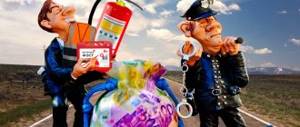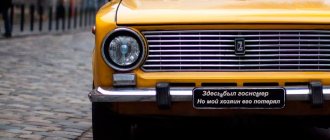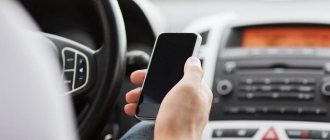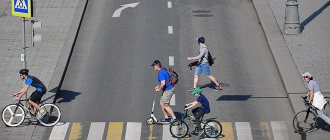Order on public roads directly depends on how correctly road users communicate with road patrol inspectors. In order to prevent unpleasant situations in advance and defend your rights, you need to know how to correctly communicate with people in uniform. There are legal norms on this issue, as well as practical developments, which serve as a brief reminder to the driver when communicating with the traffic police. As always, you need to start with legislation, that is, theory.
Communication from the point of view of the letter of the law in the event of a traffic violation
Firstly, both sides of the communication are equal, so the car owner is obliged to treat the civil servant courteously. And he, in turn, must be no less polite, courteous and objective. At the same time, there should be no personal hostility in the conversation, not to mention the negative impact of a bad mood. Violation of this “iron” law on the part of the driver - this means rudeness, use of swear words, etc. - and regardless of whether the Rules were or were not violated, will have a bad effect primarily on him.
Punishment for insulting a civil servant:
if there were no unauthorized persons or witnesses - an administrative fine of up to 2,500 rubles, an alternative option involves arrest for 15 days;
the presence of strangers increases the penalty to 40,000 rubles. or 360 hours of correctional labor. In some cases, the period of correctional labor may be 12 months.
Therefore, in the event of a potential accident, it is better not to argue with the traffic police officer, and the driver should fill out his part of the protocol. In this case, the car owner has 2 options: agree with his violation and sign that the fine will be paid within 70 days, or not admit to the offense and challenge it within 10 days. In the second case, you should try to collect evidence of your innocence.
However, there are cases when the owner of the car is absolutely confident of his innocence, and the guard, to put it mildly, in a conversation bears little resemblance to a traffic police officer. There is only one thing left to do here - try to behave as calmly and confidently as possible. And, of course, do not make retaliatory attacks, otherwise in the future it will be much more difficult to defend your case in court.
Does the car owner need to get out of the car?
Since October 2021, a new administrative regulation of the Ministry of Internal Affairs of the Russian Federation came into force, which, although it regulated the actions only of traffic police officers and other law enforcement agencies, caused a lot of speculation and misunderstandings among the drivers, which were fueled by a not entirely professional interpretation of the regulatory document on the part of auto experts and even lawyers.
In particular, there is no clause in the administrative regulations that would allow drivers who are stopped to film the actions of law enforcement officers. In this regard, suspicions arose that such actions were indeed prohibited from now on, but it turned out that this was an incorrect interpretation.
Like another rumor - that in accordance with paragraph 093 of the same Order No. 664, drivers are required to get out of the car at the request of the IDPS. The document says the following about this: a traffic police officer may offer the driver to get out of the vehicle in the following cases:
- if the driver is found to have signs of alcohol intoxication and/or illness that makes driving difficult;
- to verify the vehicle component numbers with the data entered in the registration certificate (the procedure must be carried out in the presence of the car owner or driver);
- if the driver must take part in procedural actions, if his assistance is required regarding other participants in the traffic accident, or if assistance is required from traffic police officers;
- to eliminate a vehicle malfunction discovered by the inspector;
- in case of violation by the car owner of the rules for the transportation of goods;
- if the driver's behavior threatens the safety of a police officer.
However, there are no changes in this paragraph with respect to the previous version of the Order. And yet, a number of media outlets were quick to declare that drivers are now required to do so on demand. The official must immediately get out of the vehicle.
This is not entirely true. The fact is that the technical regulations literally state the following: “...an employee has the right to offer...”, that is, this is not a requirement at all. This means that the driver does not have counter-responsibilities, so he may well ignore the inspector’s words if he considers it necessary.
This is a direct and unambiguous answer to the question of how to behave if the car owner is stopped by a traffic police inspector. Moreover, this technical regulation refers to internal documents relating to police officers, and not ordinary road users.
However, subsections of Article 027 of the Code of Administrative Offenses still regulate cases when the driver will have to obey and leave the vehicle:
- when drawing up an administrative protocol on detention (Article 027.04);
- when drawing up a protocol on vehicle inspection (Article 027.09);
- when drawing up a protocol on the removal of a car owner from driving a vehicle (Article 027.12).
Communication in practice
All experienced drivers know how to behave with a traffic police inspector, but beginners, as a rule, make a lot of mistakes. For example, they do not stop immediately or not at a specific place indicated by the inspector. Such actions are often interpreted as a refusal to stop and are punishable by a fine, although there is a clear stopping algorithm that has been developed over the years in accordance with all the rules.
Immediately after a clear signal from the traffic inspector, the driver is obliged to stop immediately. At the same time, the traffic police officer is also obliged to indicate the specific place where the vehicle will stop.
If the car stops at dusk or at night, the driver can communicate with the door closed or even locked - this is prescribed by law.
The most prudent car owners turn on the voice recorder before stopping and dictate the time and place where they were stopped by the traffic cop. You can also use a DVR for these purposes, but a voice recorder has the advantage of being hidden in your pocket. And we must remember that in case of disagreement, both parties have the right to use audio and video equipment.
The standard driver's reminder when communicating with the traffic police also recommends that in order to communicate, you need to open the side window slightly and write down or remember the name of the traffic police officer, his rank and badge number.
After his introduction, the person in uniform is obliged to notify what is the reason for the stop. And only after that, according to the law, he has the right to demand documents from the driver. However, you must always remember that it is not at all necessary to hand over your driver’s license or registration certificate for the car - they can be applied to the glass or simply shown in the window. If the other party demands by order that documents be handed over, then such demands can be legally refuted.
By the way, the list of reasons for stopping is also strictly regulated, and it is also better to know it thoroughly:
violation of traffic rules by the driver or passengers in the car;
checking the driver's documents;
assumption that the vehicle has been stolen and is wanted;
preliminary information that the car owner or passengers are the initiators of an accident or other illegal act;
providing assistance to a traffic police inspector or other road users;
if the driver or passengers witnessed the accident, it is necessary to interview them;
notification of a ban on further movement or other information related to the safety of the route.
Need to know!
If the inspector offers to simply get out of the car, then the driver has the right to refuse this.
To demand such actions, a person in uniform must present compelling arguments, including: a technical malfunction of the car that must be immediately corrected;
the employee’s intention to conduct a search - but, again, there must be compelling reasons for this;
suspicion that the driver or passengers are drunk or are violating the law;
intention to involve the car owner as a witness;
The traffic inspector is sure that the driver poses a threat to him.
Obviously, this list is quite ambiguous and “blurred”. Therefore, from a purely psychological point of view, to create a comfortable atmosphere, it is better to talk outside the car. However, as for the offer to transfer to a traffic police car, it is permissible to simply ignore it. Moreover, all people sitting in the car are legal witnesses who have every right to be present both when communicating with the traffic police representative and when filling out the protocol.
Driver's rights when communicating with a traffic police officer
Driver's rights when communicating with a traffic police officer
The driver’s rights when communicating with traffic police officers are listed in the Code of the Russian Federation on Administrative Offenses, the Constitution of the Russian Federation, and the Administrative Regulations of the Ministry of Internal Affairs of the Russian Federation dated March 2, 2009, No. 185.
The main article containing a list of driver rights when communicating with a traffic police officer is Article 25.1 of the Code of Administrative Offenses of the Russian Federation. Naturally, not all driver rights are listed in it. The rights that a car owner has are, as it were, “scattered” throughout the Code.
Let's take a closer look at some of the rights:
Right to give an explanation
The driver has the right to give explanations to the traffic police officer (Part 1 of Article 25.1 of the Code of Administrative Offenses of the Russian Federation). Such an explanation is one of the evidence when drawing up protocols, considering a case, or making a decision.
The traffic police officer or the court are obliged to take into account the driver’s explanations when making the final decision on the case. Taking into account the requirement for an objective and comprehensive consideration of a case of an administrative offense enshrined in Article 24.1 of the Code of Administrative Offenses, the motorist’s arguments about innocence are subject to mandatory verification. All the driver’s arguments relevant to the case must be studied. If a judge or a traffic police officer believes that the motorist is wrong, then the decision must contain the reasons why they do not accept his testimony. No one can simply brush off a motorist like an annoying fly and make a ruling (decision) to impose a fine, deprivation of rights, or arrest.
The driver's statement of innocence (disagreement with the protocol) can be expressed orally or in writing. This provision is enshrined in Part 1 of Article 26.3 of the Code of Administrative Offenses of the Russian Federation. Naturally, it is best to give explanations in writing. After all, oral testimony may not be reflected in the resolution in full.
The word is not a sparrow. If it flies out, you won’t catch it. This means that the driver must carefully weigh all his arguments. It is very important to correctly formulate in an explanation all your arguments, which are the grounds for terminating the proceedings, reclassifying actions, imposing a minimum sentence, etc.
No one has the right to unreasonably rush the driver when giving testimony or explanations. It is also prohibited to deliberately unbalance a car enthusiast so that he makes a mistake when writing important explanations. Such actions are unacceptable. If they were admitted, then the court may terminate the proceedings (cancel the protocol) only on the basis of such violations.
Written explanations can be given by the driver: in the protocol on an administrative offense, in a special survey (a separate form available to the traffic police officer), in other procedural documents.
You can't really go into detail in the administrative violation report. There is very little space in it to give detailed explanations on the merits of the matter. That is why a driver who does not have enough space to give an explanation in the accident report has the right to ask the traffic police officer for a separate form.
Theoretically, the traffic police officer does not have the right not to give the driver a separate form for giving detailed explanations (after all, in this case, in essence, the motorist’s right to give explanations is violated). However, I would advise car enthusiasts to always have a few blank sheets of paper in their car. They may be needed to give explanations to a traffic police officer or to submit petitions (for example, a petition to transfer the case to the place of residence).
When signing documents drawn up by a traffic police officer, you must be very careful. After all, a traffic police officer can write in a document that you allegedly gave certain explanations or committed illegal actions. If you sign this document (just put your signature, and do not reflect your testimony with your own hand) without carefully reading it, then problems may arise in the future. Always think about the negative consequences that can await an inattentive motorist who does not take care of his own legitimate interests.
It is not for nothing that the legislator has granted the driver a wide range of rights when communicating with a traffic police officer. Refusal to exercise these rights (did not read the protocol, did not receive a copy, etc.) can always be used against the motorist when drawing up a protocol or making a decision.
The right to familiarize yourself with the case materials
The right of a motorist to familiarize himself with all the materials of the case is a very important right. After all, you will agree that it is difficult to give a competent explanation (see above) if you do not first familiarize yourself with all the materials of the case.
Unfortunately, not all motorists use this right when challenging a protocol or resolution drawn up by a traffic police officer. But in vain. A lot of interesting information can be found in the materials of the administrative offense case.
For example, the information contained in the case can help the motorist when drawing up requests to call witnesses, witnesses, traffic police officers, and a specialist. It is also useful to analyze the case for the presence of evidence obtained in violation of the law (in accordance with Article 26.2 of the Administrative Code, evidence obtained in violation of the law cannot be used when making a decision).
It is also useful to familiarize yourself with the case materials because the copies of protocols issued to motorists are often unreadable. How can you defend your rights if it is even impossible to read what exactly you are accused of? Nonsense.
Familiarization with case materials often takes place in cramped conditions (for example, in a cramped and noisy office in a standing position). In such a situation, it is difficult for a car enthusiast to carefully study the provided case. However, you shouldn’t rush either, because the fate of the case may depend on your attentiveness.
What should a car enthusiast who cannot concentrate when reading the case materials do? Suggest everyone leave the office or calm down?
No, you can do it differently. The driver has the right to photograph the materials of the case of an administrative offense. Therefore, if you have a camera, you can submit not only a request to familiarize yourself with the case materials, but also a request to photograph the case materials (let me remind you that all requests are submitted in writing). In this case, it will be possible to carefully study the case materials at home. And no one will stand “over the soul.”
Right to present evidence
At any favorable opportunity, a car enthusiast should use this right. If you have evidence (witnesses, documents, video, audio), then be sure to present it when considering the case. And the sooner you do this, the better. Not using this right is a serious mistake. You should not expect that you will be able to provide any evidence later (for example, when appealing an already issued decision). Everything must be done in a timely manner.
Do not forget to also monitor the actions of the traffic police officer. In theory, he is obliged to identify not only evidence of the driver’s guilt, but also evidence of his innocence. However, it must be admitted that traffic police officers do not always show zeal in identifying evidence of a motorist’s innocence (the most common violation is failure to indicate the witnesses who were in the driver’s car in the administrative offense report). When drafting minutes, exercise your best interests at heart.
It is also worth remembering Article 1.5 of the Code of Administrative Offenses of the Russian Federation (as a general rule, a motorist is not required to prove his innocence). When a car enthusiast has no evidence of innocence, there is really nothing to present. In this case, the provision on the presumption of innocence of the motorist is used. The essence of this provision is that if there is no evidence of guilt, then the motorist is not guilty (although of course all this is in theory, but in practice everything may be different).
Right to petition
A petition is an appeal to a judge or traffic police officer with a request to carry out a certain action. For example, the driver needs to call a witness, an attesting witness, a traffic police officer, an expert, or a specialist to question him. This is done through petitions.
The petition must comply with the requirements for it in Article 24.4 of the Code of Administrative Offenses of the Russian Federation. Typically, petitions are drawn up on separate sheets of paper (two copies). The petition indicates in detail: what actions need to be taken, how this action relates to the case, etc.
The application must be registered in the office, at the station, with a traffic police officer. Make sure that people registering the petition “do not forget” to sign your copy. There were also cases when both applications were taken away from a motorist. Be careful. If you do not have a document in your hands confirming the fact of filing the application, then problems may arise later.
Right to legal assistance and other rights
The above lists only some of the rights of a motorist when communicating with a traffic police officer.
An important right of the driver is also the right to legal assistance from a professional lawyer. Such assistance can be provided from the moment the case of an administrative offense is initiated. A driver who needs such assistance must immediately submit a written request to postpone the consideration of the case and involve a lawyer.
Motorists also have other rights: the right to challenge, the right to appeal a decision, etc.
What is a traffic police officer required to do?
Firstly, when a car is stopped for violating the rules, the traffic police officer is obliged to indicate the traffic rule that was violated. Secondly, when the purpose of the stop was the participation of the driver and passengers as witnesses and witnesses, the traffic police representative must briefly and clearly inform citizens about their rights in this capacity.
The rules of conduct for a traffic police inspector require the presentation of an official ID if the driver considers his actions to be unlawful or the civil servant was unable to name a specific point of the traffic rules that was allegedly violated. The driver also has the right to record the guard’s data. And he, in turn, is obliged to name the telephone numbers by which the car owner can contact to appeal the actions of the inspector. Sometimes inspectors simply call the number of the person on duty who has the legal right to accept the complaint - and this is completely acceptable.
Grounds for stopping a vehicle
Let's start with the basics - in what cases is it legal for a traffic police inspector to stop your car? This aspect is discussed in detail in Order No. 0185 of the Ministry of Internal Affairs of the Russian Federation (clause 063).
In particular, the grounds for such actions are the following reasons:
- you violated one of the traffic rules, and this violation was recorded by an inspector using special technical equipment (radar, video camera) or visually;
- if a government official has information about the possible involvement of the driver/owner of a vehicle or its passengers in an accident, if they are suspected of committing a criminal/administrative offense. The source of such information may be internal orientation, data transmitted to the duty officer, as well as testimony of ordinary citizens (for example, during an accident) or video data that recorded the moment the offense was committed;
- if the inspector has information indicating that the vehicle he stopped was stolen/is wanted. The source of such information may be the same orientations, operational data transmitted to the duty officers, etc.;
- if those in the car may be potential witnesses to an accident or any other offense/crime;
- if a representative of the authorities is looking for a witness, who should be an uninterested (random) person;
- for the traffic police inspector to carry out administrative and regulatory actions;
- if there is a need to provide a car for the needs of the traffic police or doctors;
- to provide emergency assistance to police officers during execution or to persons injured in road accidents, as well as when committing other offenses.
Please note that stopping a car to check the documents of everyone inside is allowed only at equipped traffic police posts (clause 063 paragraph 010 of the Order of the Ministry of Internal Affairs).
If the IDPS stopped you and did not want to voice the reason for stopping the vehicle (for example, the need to involve someone as a witness), you can safely refuse the request, much less the requirement to present documents outside the traffic police post. If the reason given is the presence of an orientation, you have the right to ask to see it for review. In case of refusal, you also do not have to show your documents.
Before giving advice to drivers who do not know how to talk to a traffic police inspector, we will describe where and how you can stop the car if you see a wave of the baton. First of all, you need to be sure that it is you who is being stopped. If in doubt, feel free to drive by, but look in the rearview mirror to see if the IDPS is waving after you.
Remember that you cannot stop anywhere - the traffic police officer must show you exactly where to park the car (point 065). You cannot stop in places where it is prohibited by appropriate markings and signs (paragraph 066). But there are exceptions:
- if the vehicle is stopped to prevent the commission of an offense;
- if there is a need to take administrative and regulatory actions;
- to prevent the threat (imaginary or real) of causing damage to the health/property of other participants in the DD;
- if the order to stop is given by a patrol car with sound/light signals on.
If a traffic police officer needs a car to perform urgent official duties, he must inform the driver of the route, the purpose of the trip, and also inform about responsibility if the car owner does not satisfy his request, and not get behind the wheel (only the driver should drive the car). If the stated purpose is the pursuit of persons who have committed crimes, you can refuse to provide your car - in accordance with paragraph 068, the pursuit is carried out only in a service vehicle.
A police officer may demand to give up his seat behind the wheel if, in accordance with paragraph 126 of the Administrative Regulations, the driver should be removed from driving a car.
If the driver is late for work due to the use of his car by a traffic police officer, he can ask the IDPS to issue the appropriate certificate, and also make a note in the PL indicating the duration of the trip, the distance covered by the car, his position, full name, name of the traffic police department, service ID number.
In certain situations, police officers can forcibly stop vehicles using:
- appropriate technical equipment (service weapons, stun guns, gas canisters, batons).
- giving special signals (traffic controller gestures, traffic lights) prohibiting movement;
- blocking the road by a patrol car with mandatory flashing lights turned on.
Violations committed by State Traffic Inspectorate inspectors
The absence of a badge is an extremely serious violation.
Travel during working hours other than on official transport.
Intentionally hiding a car from view - behind bushes, trees, houses, etc.
Lack of flashing lights on service vehicles. If the traffic police car is parked in a prohibited place or other traffic rules are violated, the inspector must be held accountable under the law as an ordinary driver.
Presenting the car owner with offenses that do not exist in the law or inventing them on the fly. In such cases, the driver should make a note in the protocol “sergeant full name extorting money.” Then the probability that such a protocol will not be implemented is almost one hundred percent.
A rather rare phenomenon, but it also occurs - excessive aggression by a traffic police officer. Everything is simple here: the driver needs to call the helpline or submit an application to a higher authority.
Competently filling out protocols is the basis of your protection
In the question of how to behave if stopped by a traffic police inspector, in terms of drawing up documents about the violation, there is a “golden” rule: a representative of the authorities must prove guilt, and not vice versa, the car owner must prove his innocence. Secondly, explanations, like the driver’s signature in the protocol, are his right, but not his obligation. Accordingly, when the protocol contains the words “Signature of the violator” in a certain column, the word “violator” should be crossed out and “driver” should be written on top. This is a very important point, which means that the owner of the car denies his guilt. Also, if there is free space, it is better to write “disagree” - and then during further proceedings it will be clear that the person behind the wheel did not agree with the actions of the inspector from the very first minute. And so that in the line “witnesses” over time the full name does not appear out of nowhere, it is recommended to put a broad signature in the empty column so that there is no empty space left. You also need to know about the features of specific types of protocols.
Speed limit violation.
As stated above, inspectors must prove that the speed limit is exceeded. And if the driver is presented with a “hairdryer” with incomprehensible numbers, you can safely challenge the protocol. Because the radar should indicate that the speed was recorded specifically for this particular vehicle, and that the indicators were taken right now, and not last week.
Unfastened seat belt.
As a rule, it comes to the fore when the traffic police officer has run out of arguments in favor of another, more serious offense. However, driving without a seat belt also needs to be proven - by presenting a video recording or witnesses, and immediately. If this is not the case, then you can simply state: “Yes, of course, you can’t drive unbelted. But I just took off my belt while you were walking to my car."
Contaminated signs.
According to the 2021 rules, it is prohibited to drive a car with dirty license plates that are not visible to a traffic police inspector from a 20-meter distance. Of course, in the dark. However, to fix this violation, it is necessary to create conditions close to the specified ones, which is never done in practice. Therefore, if the driver behaves confidently and does not ingratiate himself, the matter is limited to a request to wipe the “plate”. And that's it - no fine.
Don't make excuses
The driver sometimes fundamentally disagrees with the fact that he violated traffic rules. What happens most often in such cases? As a rule, he either makes excuses or eloquently proves that he did not violate anything. Although the first thing to do is demand proof of your guilt. For example, photo and video data that clearly shows a violation. Remember that the driver is not obliged to prove his innocence (presumption of innocence), except in cases of recording an administrative offense using special technical means operating automatically, having the functions of photography, filming, video recording, or means of photography, filming, video recording (Article 1.5 of the Code of Administrative Offenses of the Russian Federation ).
Driving instructors are always up to date
Thanks to following the instructions, the driver can avoid fines, deprivation of rights and other troubles when communicating with the traffic police. However, in Russia, traffic rules have changed so rapidly in recent years that even professional drivers do not always have time to keep track of them. And only private driving instructors, who, by virtue of their belonging to “road teachers”, are always up to date with the latest events, are able to study the legislation on a daily basis. Therefore, taking a lesson or two from them is always beneficial!
| Tweet |
Driver behavior in the event of illegal actions by traffic police officers
In case of illegal actions of traffic police officers, it is necessary to protect their rights using legal powers:
- If the inspector took the documents and left in a company car, you should go to the police department and file a statement about the robbery, indicating known information about the traffic police officer.
- When the inspector did not give the documents but left, you should call the helpline. It is important to provide information about the inspector and provide details of the conversation with him.
- Sometimes calling the helpline doesn't help. In this case, you should turn on the video camera, approach the inspector, and politely ask to clearly indicate the offenses. If there is no response from the inspector, it is necessary to record his further actions on camera, then file a complaint.
- If a traffic police officer took the documents, citing the need to clarify some information on the database, call 102, ask to be switched to the traffic police officer on duty, and indicate that the inspector refuses to return the documents.
Important! If necessary, you can contact the prosecutor's office to file a statement about the traffic police inspector exceeding his official powers.
Any accusations against the driver by traffic police officers must be confirmed using video surveillance, technical devices or with the involvement of witnesses. Drivers can prove they are right and also appeal the inspector’s actions. It is important to be polite when communicating with a traffic police officer, while defending your rights, if necessary, recording illegal actions of employees using a camera or video recorder, and not admitting guilt without good reason.
You can download and print this driver's manual so that you always have it at hand.










